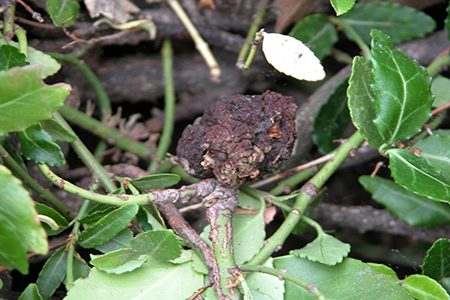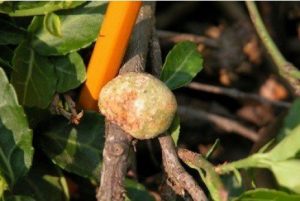
PLANT PROTECTION – CROWN GALL OF WOODY PLANTS
Crown gall is caused by bacteria belonging to the genus and species Agrobacterium tumefaciens. This bacterium can infect a wide range of herbaceous and woody plants.
Actually, the bacterium only carries the gall-causing entity, a plasmid, that contains its own genetic material. After the bacterium enters the host, the plasmid DNA is transferred into the host plant cell where it stimulates the production of more plant cells.
Symptoms
Galls or overgrowth (1/4 inch to several inches in diameter) of host plant tissue typically form at the soil line but also can form on branches or roots.
Galls are initially white, spherical, and soft but darken with age as outer cells die.
Galls can either be almost entirely on the surface of the plant and easily detached or can be almost indistinguishable from normal plant tissue except for its greatly enlarged appearance.
The bacterium survives and persists in the soil for many years. It invades recent wounds on stems or roots. Swelling can be seen 14 days following entry. Tissue near the gall is crushed. If vascular tissue is crushed, wilting can result from the restricted water movement.
Management
Nursery
-
Purchase crown gall-free plants.
-
Propagate only from crown gall-free plants.
-
Pot and propagate in sterile mix.
-
Avoid wounding plants near soil line.
-
Bud graft tissue well above soil line rather than grafting near soil line.
-
Disinfest grafting tools.
-
Avoid planting in areas known to be infested with the bacterium.
-
In infested areas first plant corn or other grain crop for several years before planting nursery stock.
-
Dip or spray seedlings or cuttings in a formulation of strain 84 of Agrobacterium radiobacter which is a biological control agent.
Home or Commercial Planting
-
Plant only crown gall-free plants.
-
Remove severely affected plants and do not replace with susceptible cultivars.
-
Plants not severely affected can be grown if fertilized, watered, and otherwise cared for well. The disease will continue but probably not kill the plant.



